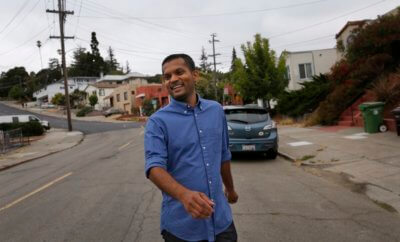Entertainment
Why Indians & Indian Americans Respond Differently To Apu

There is nothing surprising about a muted reaction from Indians when compared to the online outrage of a vast section of Indian Americans.
“I think it’s a time in our culture when people love to pretend they’re offended.” That reaction by Simpsons creator Matt Groening’s to Hari Kondabalu’s 2017 documentary, The Problem With Apu, not only reduces a complicated conversation around representation and appropriation to a comically overused cliché, but also serves to invalidate any slight or stereotype that is part and parcel of the South Asian immigrant experience.
As a resident Indian who spent his formative college years in the United States, I have difficulty empathizing with Groening, as my experiences mirror those voiced by Hari Kondabalu, Kal Penn and Aziz Ansari. From inviting guests over only to hear playful jabs about how the house smells like “curry,” to getting asked whether Halloween came early when dressing up for Diwali, cultural faux pas, whether intentional or unintentional, have followed us wherever we go.
As an ardent fan of The Simpsons, I have shared a love-and-hate relationship with the beloved, Bengal-born Apu Nahasapeemapetilon, relishing his importance to the show while simultaneously agonizing over the cultural tropes in much the same way that Kondabalu describes.
Despite the seemingly endless Twitter wars over Apu’s relevance, the most interesting response to this controversy came from Soutik Biswas who recently penned a piece titled “Not all Indians think Apu is a racist stereotype” for the BBC. In it, Biswas takes us through the diverging responses to Apu’s character, but what strikes me most is the nebulous distinction he makes between Indian Americans and the residents of “Apu’s native land.” Indian fans of The Simpsons in the homeland, he argues, seem to have no problem with Apu’s character.
While Indians and Indian Americans are not monoliths by any stretch of the imagination, there are notable differences in the ways in which the two diverse groups have responded to The Problem With Apu. Biswas quotes several prominent Indian elites, including the founder editor of the Wire, who feels Apu represents a unique element of the Indian American diaspora. A cursory glance through Indian Twitter demonstrates mainstream support for such views: “Are there actually Indian people who find #Apu offensive? The guy was the first Indian I saw on my TV set and one of the funniest in the show. #KeepApu.”
When I broached this topic with friends and strangers in Delhi, the most common responses ranged from Groening’s “people love being offended” to “is this really what we should be arguing about?” In other words, Mr. Biswas is correct — there is very little outrage coming from the homeland.
And yet, this is entirely predictable.
There is nothing surprising about a muted reaction from Indians when compared to the online outrage of a vast section of Indian Americans. Remember Avril Lavigne’s Hello Kitty? The response among Japanese Americans to the video was virtually the polar opposite of folks residing in Japan.
We cannot divorce the discourse around cultural representation or appropriation from the context in which it takes place. The context here is the Indian immigrant experience in America. Indian Americans constitute 1 percent of the U.S. population and are found at all levels of American society, from CEOs to astronauts, taxi drivers to restaurant owners.
When such a heterogeneous population gets whittled down to a harmless, head-bobbing caricature and proud owner of a Kwik-E-Mart however, we suddenly reduce this vibrant diversity into a single stereotype.
This isn’t readily apparent when you’re thousands of miles away and part of the majority culture. It was not till I landed in the land of the free and home of the brave that I became acutely aware of my identity as an Indian foreigner. It was not till I was escorted by an abrasive Customs and Border Patrol officer to a separate room for further questioning that I became aware of what it means to be brown in America.
When I tried to have this conversation with friends back home however, I was usually met with “well, what did you expect” or “you’re being dramatic.” Perhaps, but this doesn’t change a few fundamental facts about the differences between the Indian and Indian American experiences.
You are never going to be mocked for your head bob in India.
You are never going to be ridiculed for the scent of dal tadka and jeera rice in your lunchbox in India.
These VIP experiences are reserved for the privileged immigrants who manage to make it to America’s shores. We put up with it because we believe it is the price we have to pay for entry.
As a minority, race underpins every encounter you have in America, even for the more privileged immigrant groups. Some are benign, while others may end up costing you your life. In this context, representation matters. What you see on screen can wield a powerful influence on how you perceive entire communities. Having Indian Americans such as Mindy Kaling, Kal Penn, Hari Kondabalu, and Hasan Minhaj get the screen time they deserve represents the breadth of the immigrant experience far better than a caricature ever could.
So, with all due respect to Mr. Groening, asking for better representation at the drawing board, in the fictional and real world, is not simply a matter of being offended. It is about not only recognizing, but actively celebrating and embracing the diversity that constitutes America. It is about understanding that having a White man voice a caricature of an Indian can do real damage to some communities.
Hank Azaria clearly understands this, judging by his call for better representation and an unprecedented offer to step aside. It is time for us to shift the conversation away from the fractures between groups fighting for proper representation and instead focus on creating a more inclusive media for everyone. The fact that some Indians residing in India do not find Apu offensive does not invalidate the grievances of those Indian immigrants who have experienced America’s wonders and flaws firsthand.
As we continue the conversation in the media and beyond, I hope we can bid adieu to stereotyped depictions tolerated in the America of yore, and embrace a more inclusive and accurate depictions of the vast, messy, beautiful diversity around us.
To my good friend Mr. Nahasapeemapetilon, I say “thank you, come again!”



